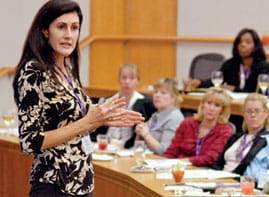From cryptocurrency to robotrading, a two-day conference at Kellogg investigated the technological revolution underway in the financial sector.
“It’s an exciting time to be in the so-called boring world of banking,” said Thomas Curry, comptroller at the U.S. Office of the Comptroller of the Currency (OCC). Delivering keynote remarks on the second day of the
Kellogg Public-Private Interface (KPPI) conference on Consumer Finance and Fintech, he pointed to radical new technologies—from advanced data analytics to artificial intelligence—that are converging in the financial sector. “Based on the volume of change coming at us today, we are in the midst of a very large wave of potential progress.”
Virtually every facet of the financial industry is grappling with both threats and opportunities presented by emerging technology. Computing power and automated processes, for instance, promise the world of finance huge gains in efficiency. But a host of other questions—how ought governments regulate new financial technologies, or fintech? How much security can consumers expect from new methods of exchange?—have sparked important debates. “We want to facilitate innovation and competition while explicitly addressing the risks,” said Lael Brainard, Governor at the Federal Reserve Board and former Undersecretary of the Treasury. “I don’t yet feel like the guardrails are [sufficiently] secure or well understood to make sure this entire ecosystem can flourish.”
The two-day conference (April 27-28) convened the two main financial regulators (the Federal Reserve and the OCC) with leaders from financial services and academia to discuss the powerful forces pushing change, as well as the difficult balancing act between innovation and safety—both consumer and systemic—that faces firms and regulators. “Progress requires informed and open conversation between leaders in business, academics, and public policy to navigate a complex and rapidly changing environment,” said
Janice Eberly, the conference organizer, James R. and Helen D. Russell Professor of Finance, and Faculty Director of KPPI.
Outlined below are four major takeaways from the conference.
The benefits of efficiency
Peter Cherecwich, President of Corporate & Institutional Services at Northern Trust, recently oversaw a yearlong automation of the company’s private equity administration process. (IBM helped plan and execute the project.) "Administration for Private Equity is manually intensive, with paper based legal agreements and capital calls taking a significant amount of time to draft, execute, and audit." Cherecwich said. By automating this contractual roundabout with distributed ledger technology (or blockchain as it is commonly known and made famous as the technology basis for the electronic currency Bitcoin,) he plans on automating roughly 30 percent of the fund administration job. This, in turn, means cost savings for all as the data is available in an electronic and immutable form. “For every player along the chain, including investors, costs will decrease and profits will go up; that is progress from my perspective.”
Despite the complexity of implementing this technology, Cherecwich noted that the core challenge was not actually creating the platform, but building support for the transition, both internally and externally. “You need to get people accustomed to it, and get governments to recognize it.”
These increases in efficiency have not only benefited big financial players, but also smaller institutions; in many ways, new technology even favors the agility of small companies, which can capitalize on innovation much more quickly. “It seems that many of these technological benefits have shifted to small institutions in recent years,” said Steven Chaouki, executive vice president of financial services at TransUnion. Take the consumer lending market, which was “eviscerated” coming out of the financial crisis. This dynamic opened room for small organizations to “leverage technology to provide for niche needs,” he said—something that could be done with far less capital than once was needed. “The elimination of scale in technology,” said Chaouki, “has allowed companies to be successful without a book of $300 billion, or $100 billion, or, frankly, even $5 billion.”
Avant is one example of this success. For decades, banks have relied on a few simple variables to determine loan eligibility. Avant, which was founded in December of 2012 and holds a $3.5 billion portfolio, scans far more broadly to match a loan to people in a way that banks might overlook. “A ton of data goes into making these decisions,” said Suk Shah (KSM 2012), Avant’s chief financial officer. “Our ability to use analytics and decision-making horsepower—and do it quickly—is the next-generation way of providing credit to consumers.”
Expanding access to financial services
Avant is one company among a vast array that has the potential to offer financial services to communities that are typically ignored.
Great opportunity exists across the country through mobile technology to reach underserved and underbanked markets, which are worth about $140 billion,” said Garvester Kelley, Community Development Director in the Community Development and Policy Studies Division of the Federal Reserve Bank of Chicago.
The people in these communities typically rely on payday lenders or check-cashing companies, which charge exorbitant fees for simple financial services, he explained. If those fees could be reduced through the use of innovative fintech products, it would be good for both the consumer and the company offering the product.
But Kelley did not downplay the risks to consumers. Banks today are FDIC-insured, and the funds in customer accounts are therefore covered. As small fintech firms offer products traditionally provided by banks, funds associated with the transaction that the new product enables might not be insured. So what happens to the consumers’ money if the fintech company suffers a major financial collapse?
Those who are economically disadvantaged are the last to recover if there is some type of financial crisis, Kelley explained. “We found that out in the last recession,” he said. “Plenty of concerns remain despite the opportunity that this technology brings.”
The role of regulation
Regulation, of course, is one way to mitigate these concerns, but a delicate balance is required. Can government maintain space for innovation (and failure) while expanding access to underserved markets and protecting consumers?
There was widespread agreement throughout the conference that the question of regulation was necessary, complicated, and also unanswered. “Fintech fundamentally challenges our current regulatory regime,” said Aaron Klein, policy director at the Brookings Institution’s Center on Regulation and Markets. “We want to democratize access to capital, but the business of investing and the business of being scammed often overlap.” So how and where can the government effectively intervene without muzzling innovation?
In one specific instance—algorithmic trading, in which algorithms rather than people allocate investment portfolios—Joshua Rogers from Arete Wealth Management suggested the government adopt standardized guidelines similar to air safety protocols. “The SEC should take a lesson from the FAA,” he said “When you fly an airplane there is a set of steps that every mechanic has to follow—and those sets of steps are determined by ISO-9000.” A similar rulebook on some fintech processes, he suggested, should be adopted.
The open question of security
Tied closely to regulation were questions of security: how can fintech protect assets in a much more diffuse market. “We’re at a very fragile moment,” said Gareth Jones, cofounder and managing partner of the FinTech Collective. “There are people whose job it is in Washington to figure out what to do when we wake up one day and everyone’s bank account says zero.”
But the challenge of security, noted Caitlin Long of Symbiont, is not new. Counterfeit coins have been found contemporaneous with some of the world’s oldest money. “Let’s face it: there is no absolute guarantee of security in
anything,” she said. “But from a relative security perspective there is no doubt that new technologies, like distributed ledger, are safer.”
Beyond the challenge of security, the overwhelming sentiment was one of promise: innovation is inherently risky. Moreover, risk in the financial system can be costly not only to individuals, but to the economy and society. Hence, innovation must be balanced with a focus on safety and access. But there is the potential for a more efficient and accessible financial future.






